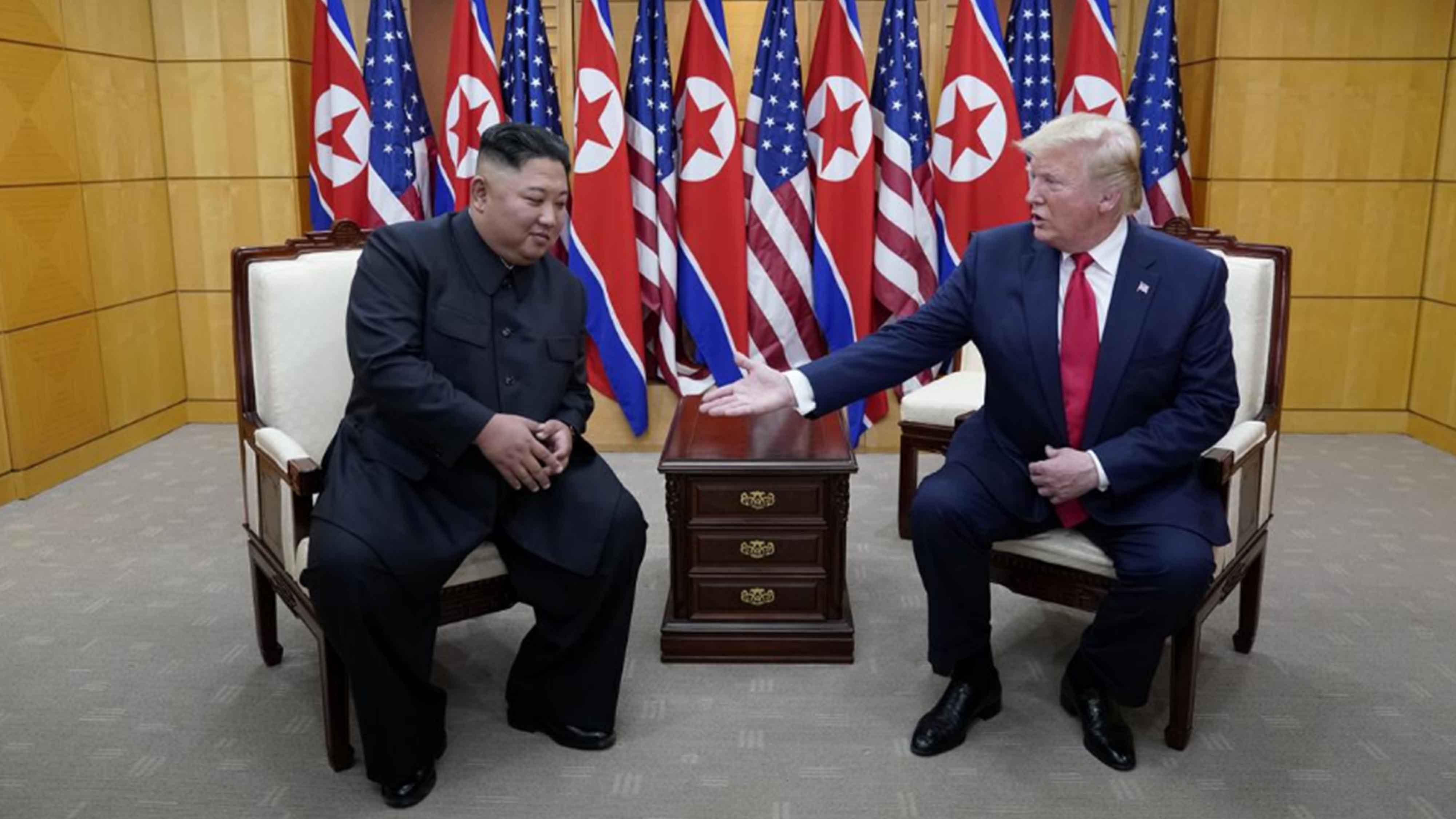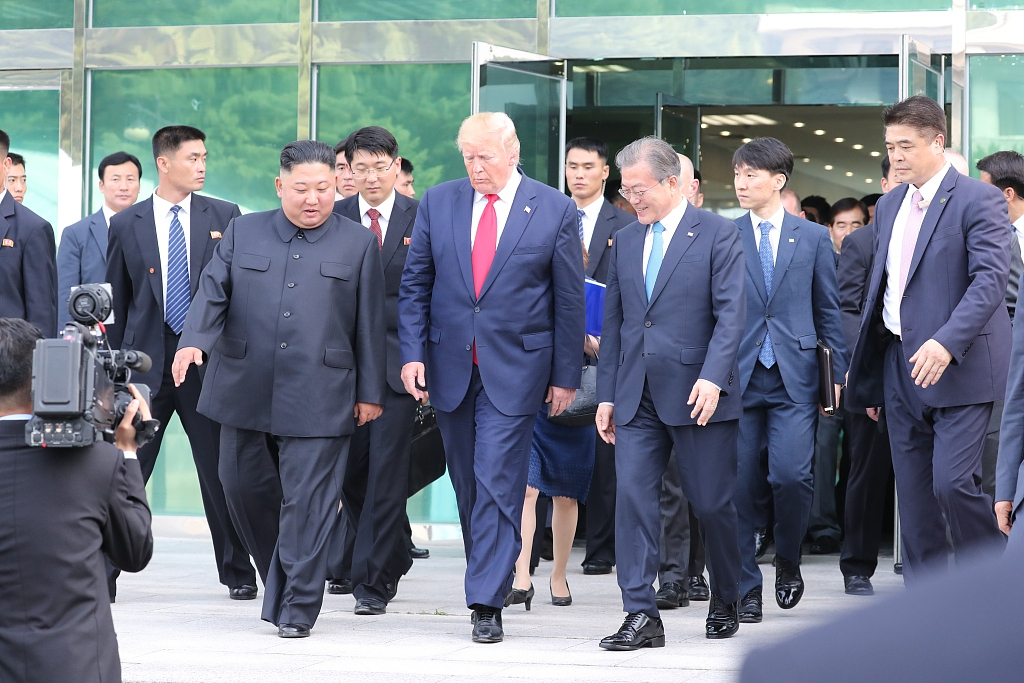

Editor's Note: Tom Fowdy is a British political and international relations analyst and a graduate of Durham and Oxford universities. He writes on topics pertaining to China, the DPRK, Britain, and the U.S. The article reflects the author's opinions, and not necessarily the views of CGTN.
Yesterday Donald Trump made history by becoming the first U.S President to step into the Democratic People's Republic of Korea (DPRK), meeting with the DPRK leader Kim Jong Un in a brief summit which saw the two sides recommit to working level talks, with the President even proposing a future invitation for Kim to visit the White House.
The meeting originated from a Trump tweet seeking to reach out to Kim, even if it was just to say “hello”. It came on the aftermath of several months of lackluster progress between the two sides, Trump having previously walked out on a meeting between the two sides in February over an inability to come to an agreement.
Whilst some critics have labelled Sunday’s event as a “stunt” and a “photo-op”, we should not play down the diplomatic significance of what such a summit can offer in the long run. Symbolism can count just as much as substance in diplomacy, and rather than focusing on extensive lists of demands, commentators should look at the bigger picture and recognize that a positive transformation in the way that America and the DPRK relate to each other is absolutely crucial going forwards to achieve anything substantial. The idea that continued confrontation can achieve results is completely negligent of history itself.

U.S. President Donald Trump (R) meets with DPRK leader Kim Jong Un at the Demilitarized Zone separating the two Koreas, June 30, 2019. /VCG Photo
The entire prism of U.S.-DPRK relations has been dictated by a state of war. The Korean conflict from 1950-1953 ended with no formal peace treaty or conclusion, but a status-quo armistice, rendering the disputes which brought about that conflict as unresolved. As a result, both countries have continually perceived the other in unclenching adversarial terms, which have developed over time into what scholars have described as “crisis diplomacy”, marked by the constant risk of conflict and a total absence of any stability or formal channels to resolve problems.
This long term context has been instrumental in Pyongyang’s decision to go nuclear. After the demise of the Soviet Union and the end of the Cold War system, the balance of power turned drastically against the DPRK and its entire foreign policy was re-calibrated around the goal of survival.
The Kims believed there was no other way to hold their own in diplomacy other than the guarantee of the nuclear bomb. Whilst of course this itself has placed the country on a greater collision course with the U.S. including most recently in 2017, nevertheless it is important to understand how the persistence of “war like” relations got us here.
Now, for all his many flaws and problems, Donald Trump is actually experimenting with something new and unprecedented. The President has been willing to experiment with a new channel of diplomacy in his approach to Kim Jong Un, reversing a long held principle by the White House that the President ought never to meet the DPRK leader. In doing so, despite his approach not being completely perfect, he has been more willing than anyone ever before to move past the “war like” prism which has locked U.S.-DPRK relations into that framework of endless crisis.

U.S. President Donald Trump walks with DPRK leader Kim Jong Un and Republic of Korea President Moon Jae-in at the Demilitarized Zone seperating the two Koreas, June 30, 2019. /VCG Photo
Given this, such a meeting is not really a photo-op, but another hammer into the wall which has upheld decades upon decades of hostility. Yes whilst it is a meeting that achieved nothing substantial, its symbolism is important because it illustrates that Pyongyang and Washington do not truly need to be enemies. In doing so, such diplomacy has the potential to change the mood between the countries and in turn, unlock concessions and compromises which were not possible before.
On that note, successful international relations are not built upon sand or one sided, coercive demands, they are ultimately built upon the framework of which the two countries can react to each other and solve problems, in which trust and reliability can be established.
Those who criticize Trump’s move want to uphold the status quo, they somehow believe that the atmosphere and “state of war” is somehow necessary to force the DPRK towards denuclearizing. They refuse to come to terms with the fact that the country even continues to exist. But in doing so, they prolong the conditions and sentiment of which created a nuclear Pyongyang in the first place.
Given this, Trump’s visit was short, but it was sweet. It has injected a new hope into the DPRK-U.S. relations, not only reviving prospects of successful diplomacy, but also by recognizing that to improve ties between Washington and Pyongyang and move past the entrenched mindset of crisis is the only way to achieve feasible and workable results. As a result, this meeting was worth every minute. Through it there is nothing to lose and everything to gain.
(If you want to contribute and have specific expertise, please contact us at opinions@cgtn.com)

Copyright © 2018 CGTN. Beijing ICP prepared NO.16065310-3
Copyright © 2018 CGTN. Beijing ICP prepared NO.16065310-3